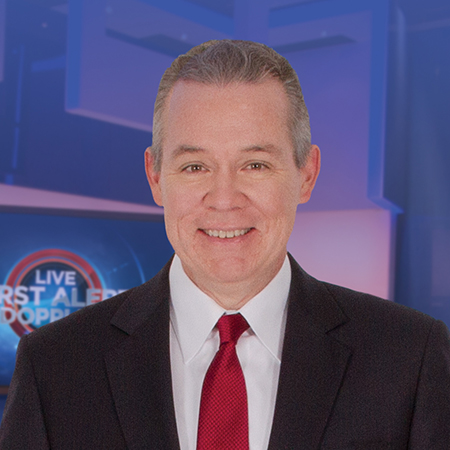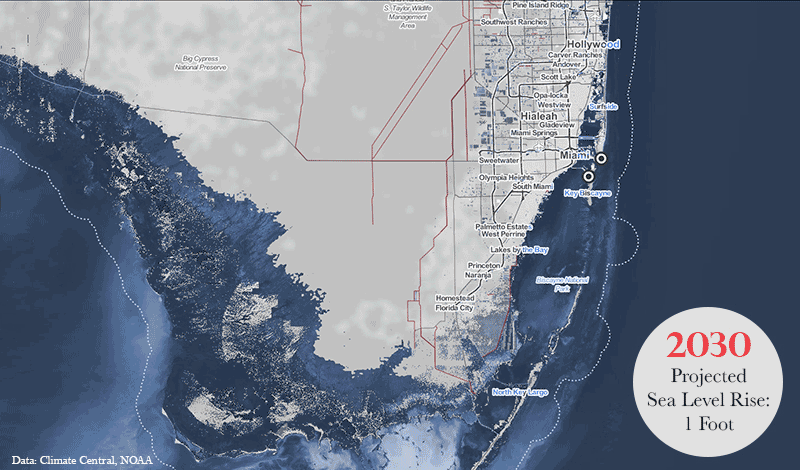When it comes to informing the public about global warming, few people have as much influence as the hundreds of local weather forecasters at television stations across the United States. That prime perch has not been lost on non-profit groups like Climate Central, which works with TV meteorologists to broadcast the message of climate change.

One of those leading the way on this is John Morales, chief meteorologist of the NBC affiliate in Miami. Morales — who has worked in Miami for 25 years — uses his broadcasts and Twitter feed to tie weather trends in South Florida to the broader influences of climate change.
In an interview with Yale Environment 360, Morales — one of the few broadcasters elected as a fellow of the American Meteorological Society — discusses the heartening shift away from climate change skepticism among the nation’s TV weather forecasters, the positive public reaction to his discussion of climate change, and the daunting threats facing the Miami area, which has been ranked as one of the regions in the world most vulnerable to sea level rise.
Yale Environment 360: In your weather reports, you occasionally incorporate information regarding climate change. What kind of information is it possible to include in the limited time that you have in your reports?
John Morales: My daily job is to tell people what to expect weather-wise and to be weather-ready and storm-safe. On occasion, when the opportunity arises, I like to mix in some climate information, as well. Now, that can be as mundane as talking about a daily record, whether it be a maximum temperature record or the ones we’re getting very frequently down here in South Florida, which are the highest minimum temperature observed for a certain date. Often I can tie that in with other trends that have been observed, or perhaps what might be expected as global warming continues to advance.
Just recently, for example, we entered a period here in which our nighttime lows are setting records and our heat index values have been quite high. Last week, we had our first heat advisory in seven years issued here in South Florida. It was for heat index values between 105 and 110. It just so happens that was the week that Climate Central had released their trends of dew points and how dew points have changed since 1980 in many TV markets around the country. It turns out for South Florida, there’s been an increase of over 1-degree average summertime dew point temperatures since 1980, and of course that affects the heat index quite a bit. So I showed that graphic on the air and tied it into whether people had been feeling muggier summers of late.
e360: My impression is that incorporating this kind of information is unusual for a broadcast meteorologist. Why are you doing this, and should more broadcast meteorologists be doing something along similar lines?
‘It is our responsibility to communicate the state of the science of climate change.’
Morales: As far as whether it’s unusual or not, I think it’s still the exception to the rule, but that is changing a bit. Just by looking at Climate Central’s weekly Climate Matters email blast, there seems to always be two or three weekly examples of broadcast meteorologists in different markets who are doing precisely that — talking about climate change on the air. I look at some of those examples and often they’re tied in directly to something that’s happening during that week for them. Sometimes they’ll just do it independently.
In my case, I just think that when presented with an opportunity, it should be taken advantage of. We’ve had quite impressive short-term rainfall accumulations that blow people’s minds in terms of just how much rainfall could accumulate in a sub-tropical climate like this when the triggers are there and you get 22 inches of rain in just 8 or 12 hours. I can get on air and present the event and look at the video from the flood and look at what factors triggered this event, but also I’ll point out that a warmer atmosphere holds more moisture, and when it rains, it tends to rain more strongly. Perhaps I’ll present a supporting graphic.
Ten years ago we had a big problem among broadcast meteorologists, who by greater than 50 percent seemed to be in the skeptic camp of anthropogenic global warming, according to some surveys. They either weren’t communicating it, or they were finding ways to disparage the state of the science.
Recognizing this, Bob Ryan, a former president of the American Meteorological Society (AMS), and myself, we co-authored an article in 2007 in the Bulletin of the American Meteorological Society saying that our profession is the face of science for the general public, that it is our responsibility to communicate the state of the science of climate change, that, in doing so, we need to divorce ourselves from political, religious, personal, and other views and just simply communicate the state of the science at the time.
e360: There was a survey of AMS members done a few months ago and about 70 percent of respondents said they believe that climate change is either entirely, largely, or mostly caused by human activities. I think 14 percent also said they believed that it’s caused equally by man-made versus natural forces. What’s your take on that result?
Morales: When the AMS and other organizations recognized that we had this particular challenge [of skepticism], [we began] some efforts that are still ongoing today.
‘I’ve been doing this for years and have yet to receive a negative email about what I communicate on air.’
For example, there’s a group called the Station Scientists Committee, which is all about helping broadcast meteorologists communicate not just about climate change, but about astronomy and seismology and other subjects that on occasion come up and we’re expected to discuss on air like we’re experts about it.
I think through education and having broadcast meteorologists properly understand the science, there’s been a tremendous shift in the views of the broadcasters in those ten years.
e360: Any feedback, positive or negative, from viewers when you communicate information regarding climate change?
Morales: I’ve been doing this for years and have yet to receive a negative email about what I communicate on air about this subject. I’ve had no negative feedback from management, either, and I didn’t ask permission to start doing these things. I just said, “Well, I’ll do it and they can ask questions later.” They didn’t.
On Twitter, where I have over 25,000 followers, I’ll occasionally get some push back, but stuff that’s just not based on facts. Usually they’ll say, “Yeah, it was the same way 50 years ago,” and there are usually some flaws in what they’re pointing out.
I’ll tell you, anecdotally, that when I go out and interact with the public in different venues, people thank me for, as they say, being “the only one that’s talking about these subjects on air.” In South Florida, where we go through these sunny day floods where the salt water creeps up and floods the streets of Miami Beach and other locations because of sea level rise and other factors, people are very aware. It’s been increasingly present in the news cycle here, especially in traditional print media.
Now, we get climate projections not just from the IPCC [Intergovernmental Panel on Climate Change], but the U.S. Army Corps of Engineers, which has projections for how much water can be expected by the year 2100. We have projections from the Southeast Florida Regional Climate Compact — the four counties along southeastern Florida. Whenever you couple these projections with inundation maps of what Miami Beach or Greater Miami will look like, people are always surprised and ask a lot of questions. I think people are very much more aware today than they were five or 10 years ago.
Now, people say things like, “Well, you know I had vaguely heard about this, but I had never seen a map. Look how most neighborhoods are going to be inundated.” Then they’ll start asking questions: “When did you say this is going to happen?” “How can we stop it?”

e360:Let’s talk about the future. By 2050, some projections put sea level rise in Miami around 0.8 to 1.3 feet higher than today. By 2100, it jumps to 2 to 3.6 feet. Is that a Miami that’s livable?
Morales: It’s going to be tremendously challenging to live in Miami under those conditions, especially in some lower parts of our metro area, like Miami Beach. We already face some of those challenges during the king tide [extremely high tide] in the fall, and we had a particularly high king tide this last cycle in September and October because of other exacerbating factors, including far above normal sea surface temperatures, so the ocean probably expanded a little bit more in our immediate area. The Gulf Stream is slower now, so you just don’t have the water being evacuated out of our area. It just accumulates down here, coming out of the Gulf of Mexico and around the Florida Straits.
Between that and the sea level rise and all those other factors, we had a really frequent and deeper-than-normal flooding event during the king tide this last fall. People are very much aware of what’s going on, and also very much inconvenienced. It was difficult to get to their homes and it was difficult to come in and out of stores and hotels. The tourists were wading with their suitcases into the hotels.
Imagine, then, those types of nuisance floods not just happening 10 or 12 days, like last year, but happening 50 days a year or eventually 100, or even half of the year. It’s going to be very difficult.
Places like Miami Beach are investing quite a bit of money, including a half-billion dollars in pumps that will basically take the water that’s flooding the streets and pump it back out into Biscayne Bay. A lot of studies show, by the way, how bad the quality of that water is that’s going back into Biscayne Bay. They’re also elevating street levels.
‘There needs to be some reconsideration of how things are going to be planned at the coastline.’
There are areas in Miami Beach now where if you’re sitting in an outdoor cafe, basically you’re sitting lower than the street levels, so your head is just above the street level.
The problem is that this is all a patch. Maybe it will work between now and 2050, based on those modest sea level rise projections, but it may not work by 2070 and 2090 as the water continues to rise. Then it very much becomes an existential problem for places like Miami Beach and Fort Lauderdale — known as the Venice of America — to still have a sustainable environment to live in.
e360: Do you agree with the mayor of South Miami who said, “A slow and graceful depopulation is the way to go”? How do we go forward from here?
Morales: Yes, Phil Stoddard. Some of the things that he points to are going to be even worse challenges. For example, if we’re going to buy property in America, we all usually get a loan to buy property, right? We’re leveraged and that requires mortgages to be insured. One of the points that Phil Stoddard brings up is that eventually the insurance companies are going to stop insuring these more vulnerable communities that are seeing the water rise more frequently, and of course, in case of a storm surge, have the storm surge be higher and penetrate further inland and therefore greatly damage those properties. Either the insurance is going to become so expensive that people can’t pay for it, or [companies] are simply going to stop insuring. When that happens, it’s going to be very difficult for people to buy properties because they would have to buy them for cash and that just doesn’t happen very much in America. It becomes a big problem, and people, probably just by economic force alone, are going to start retreating from the coast.
I think long-term there needs to be some reconsideration of how things are going to be planned at the coastline. Here in the United States, when things get wiped away by hurricanes, everybody comes back and says, “We will rebuild.” There needs to be a reevaluation of the “We will rebuild” mantra in many places, whether it’s the coast of Mississippi, or places that got hit hard by Hurricane Katrina with that 25 foot storm surge, or South Florida. These pumps that they’re installing, it’s great while [a politician] needs to get reelected, but 30 years down the road will they still work? Can they keep up with the amount of water that’s flooding the streets every day? I’m not sure that’ll be the case.
e360: Last year, evidence surfaced that Florida Governor Rick Scott had banned the words climate change and global warming from meetings and other official communication. On the other hand, there’s this innovative Four County Compact in South Florida that coordinates mitigation and adaption efforts across county lines. What’s your take on how well, or not, public officials in the region are preparing for rising seas and other climate threats?
Morales: I think it’s all happening from the bottom up.
ALSO FROM YALE e360Rethinking Urban Landscapes To Adapt to Rising Sea Levels

It happens at the local level because in a particular municipality leaders are aware of what the problem means for their community. They’ll start to put pressure on some of their colleagues up the chain. They’ll go from the municipality to the county. Miami-Dade County now has a resilience officer, a position that didn’t exist before.
The counties might try to put pressure on the state or state legislature. But that’s a challenge at the state level. The environmental legacy of the present administration in Florida is not pretty. The way that budgets have been decimated in certain departments over the last five or six years, it’s just left the state in a very, very dire environmental condition, which is going to be really hard to recover from.
Again, it starts as local municipalities see what the problems are and they put pressure upwards. I think that the Southeast Regional Climate Compact, which is pretty innovative, is an example for what might happen elsewhere in the country.